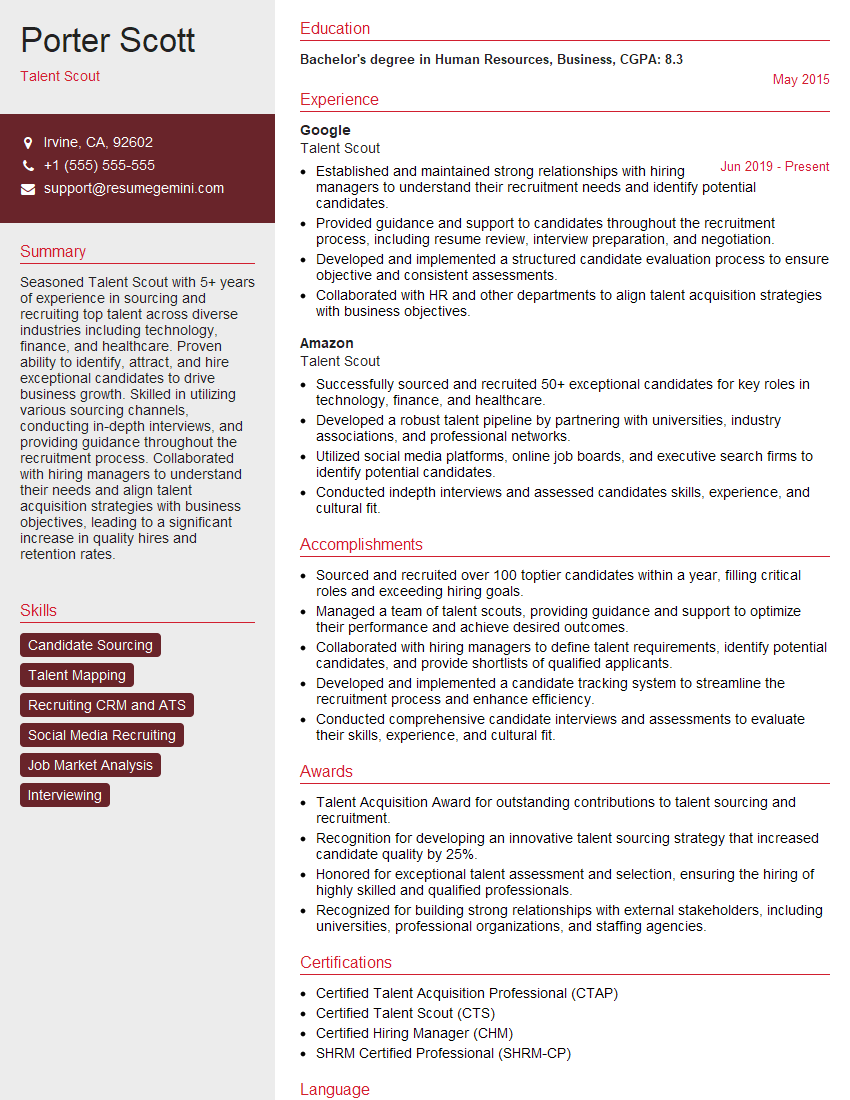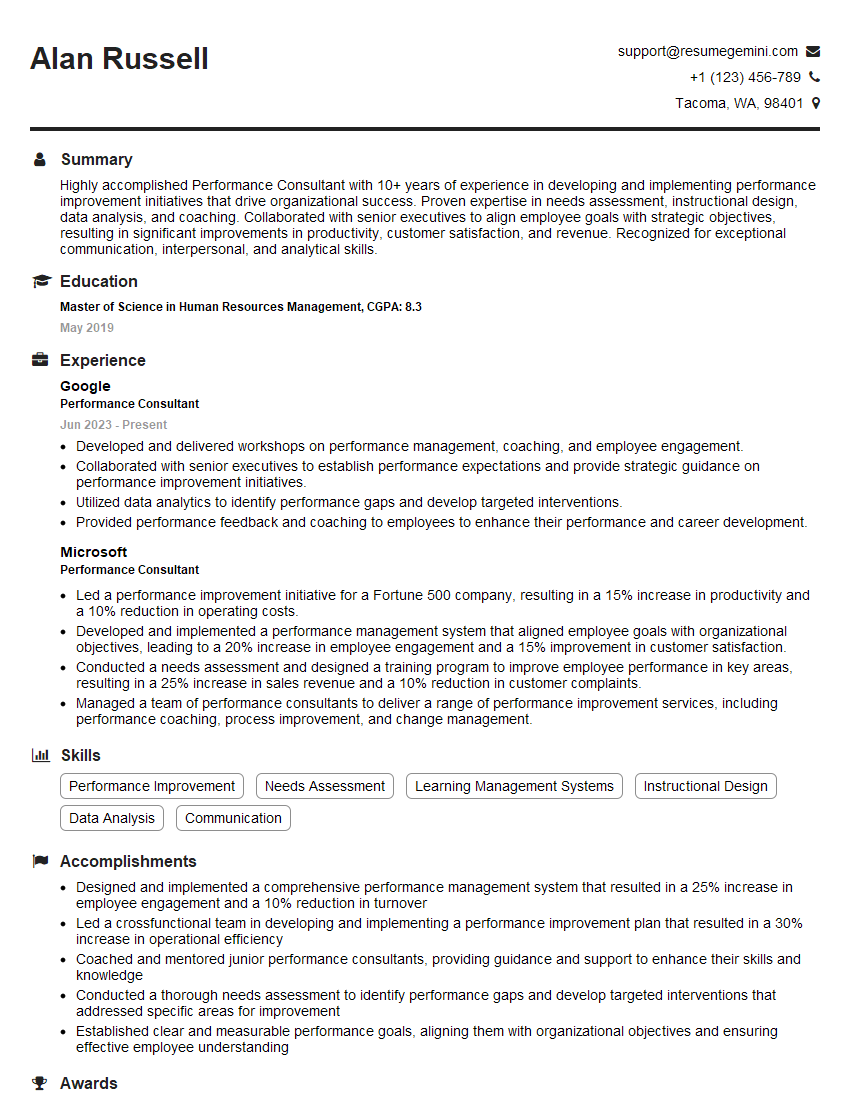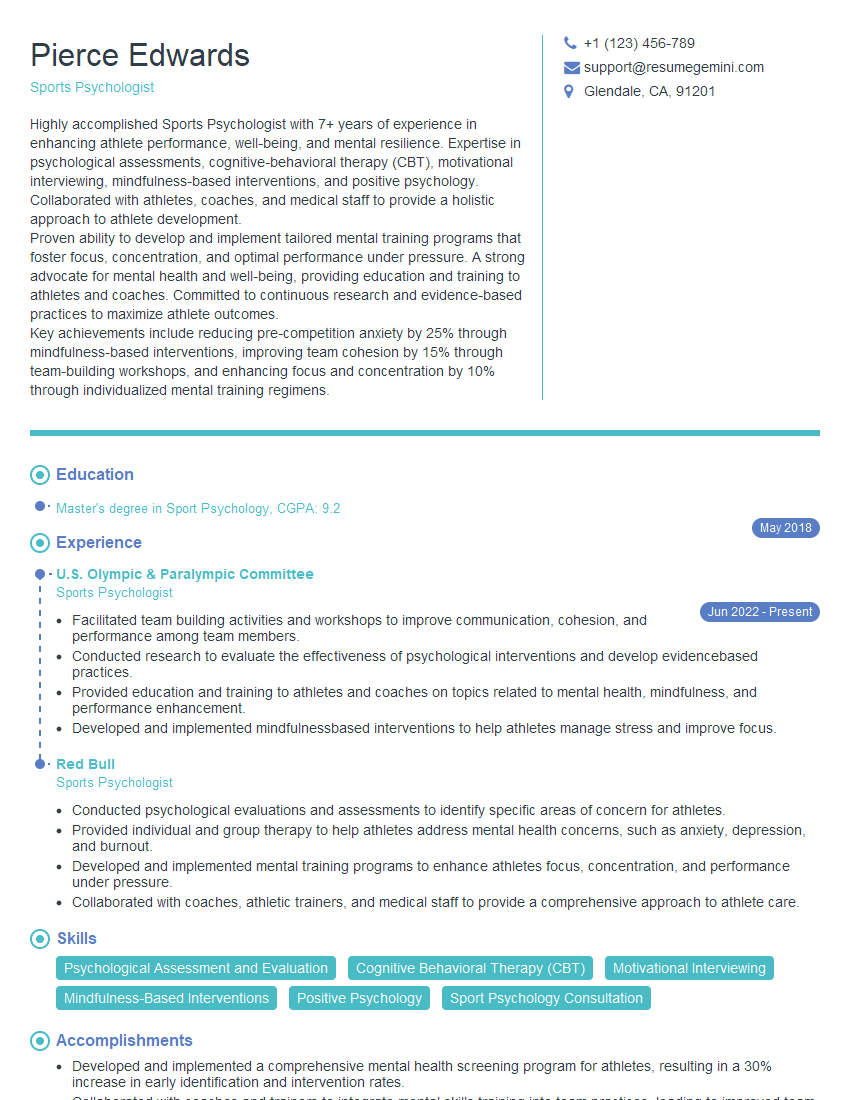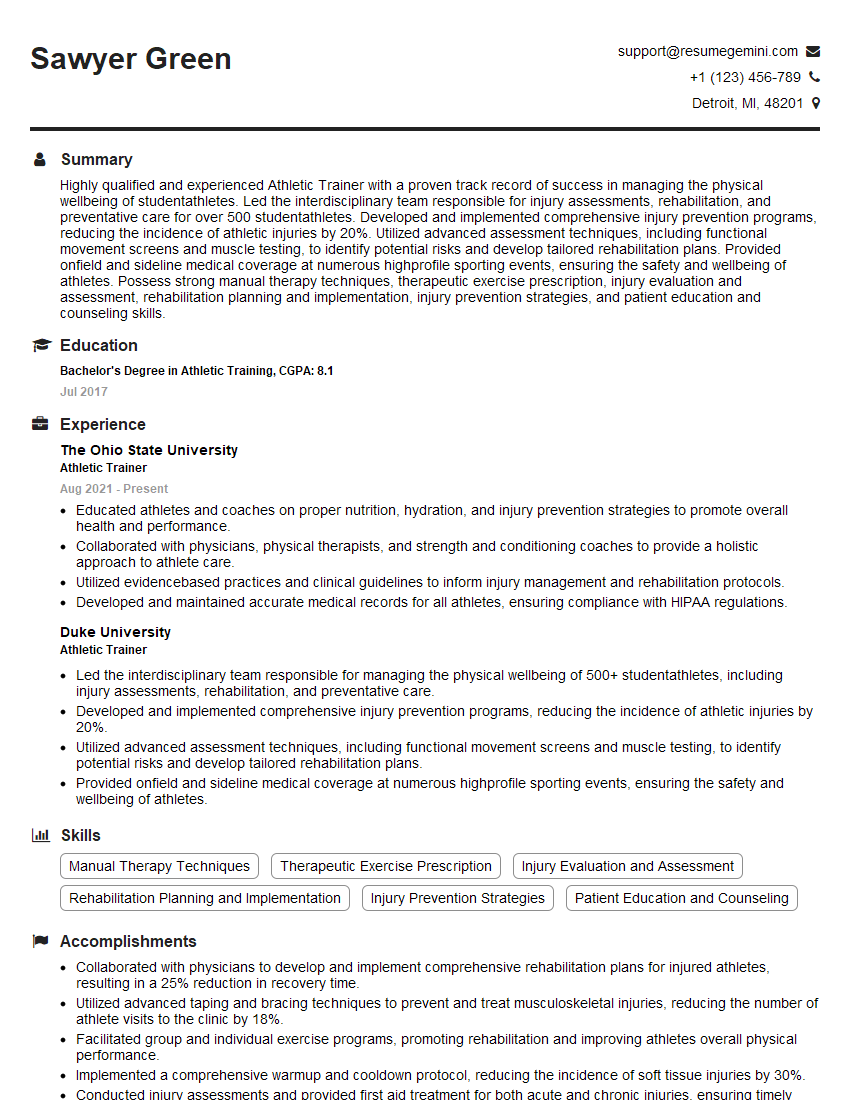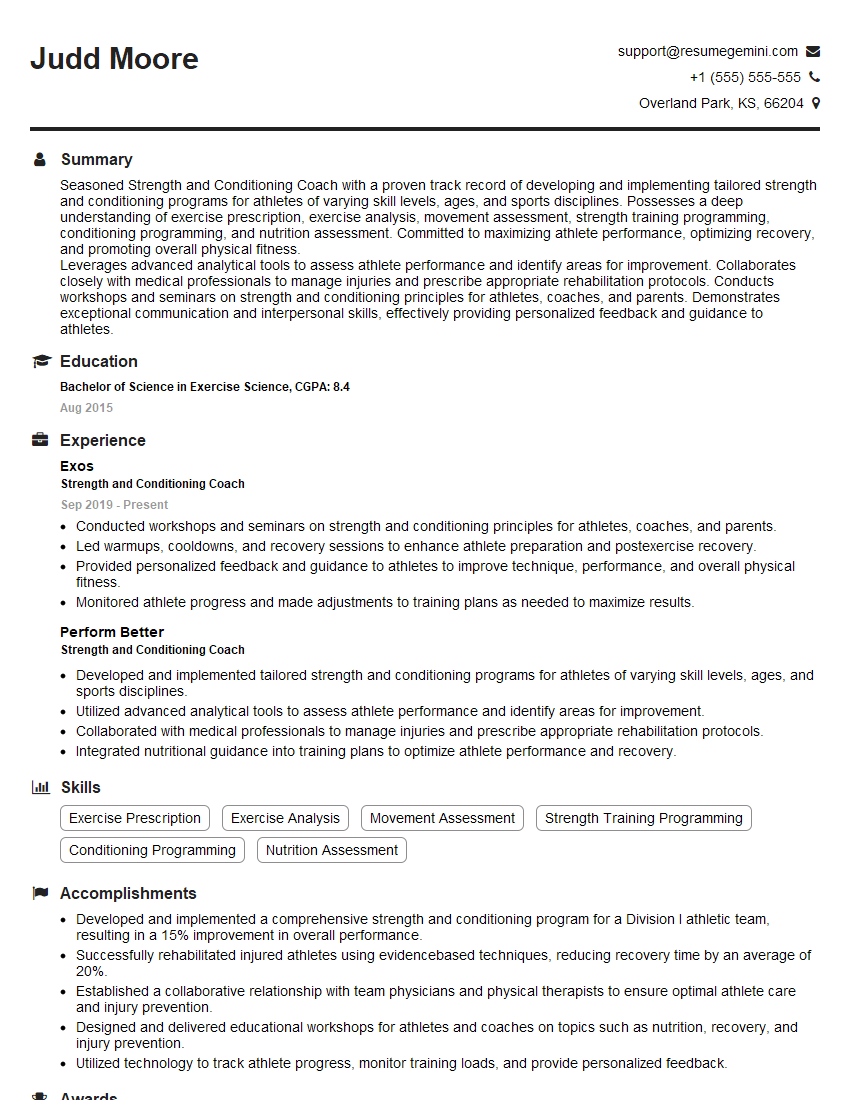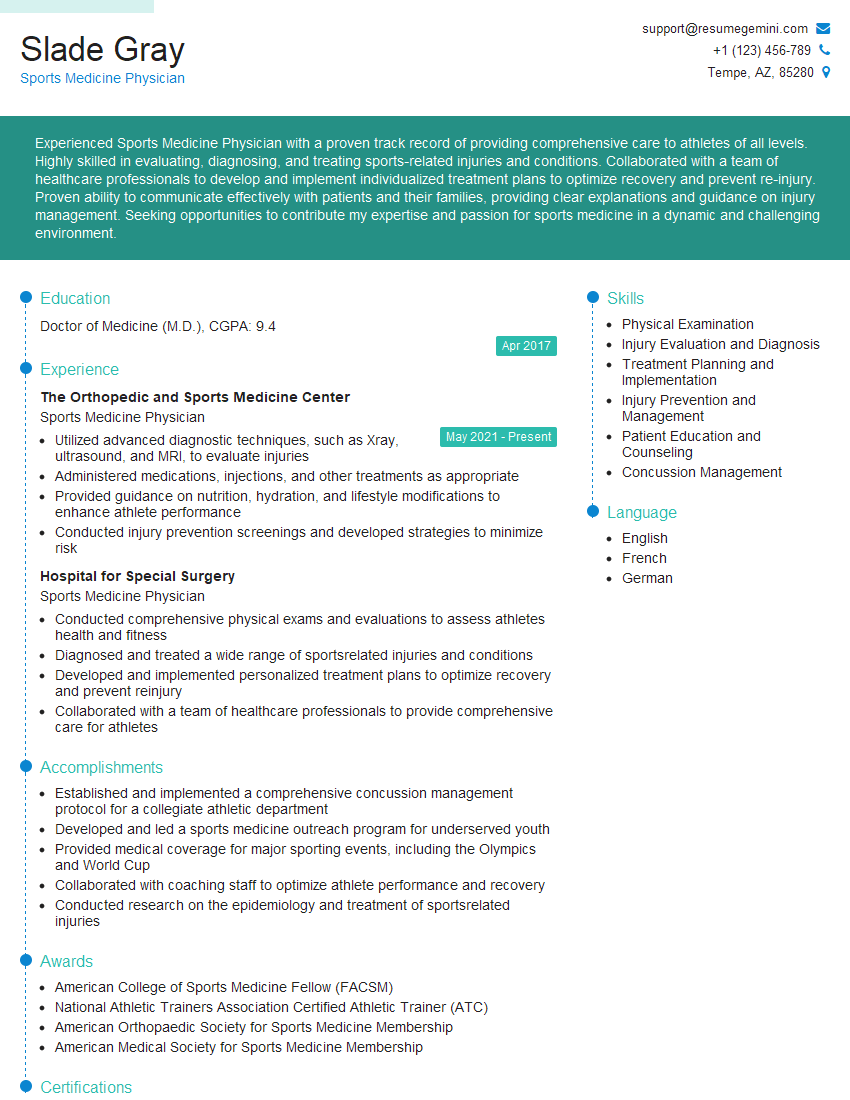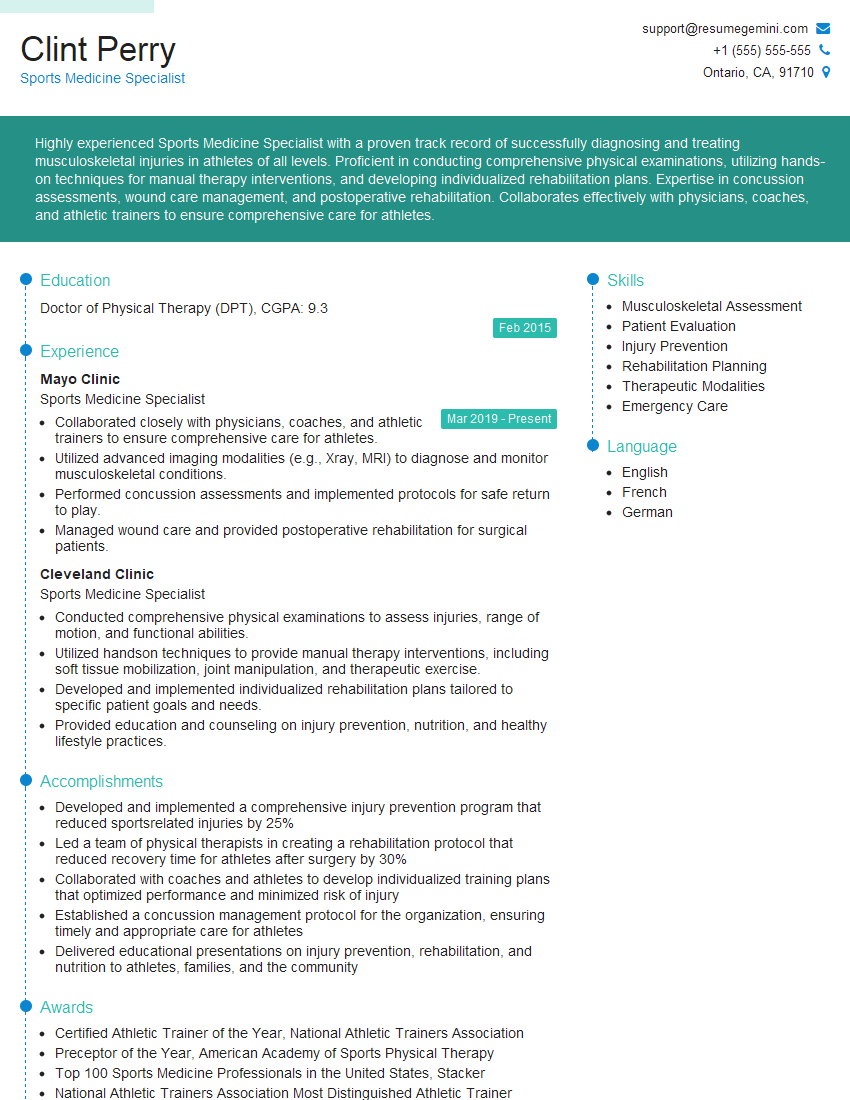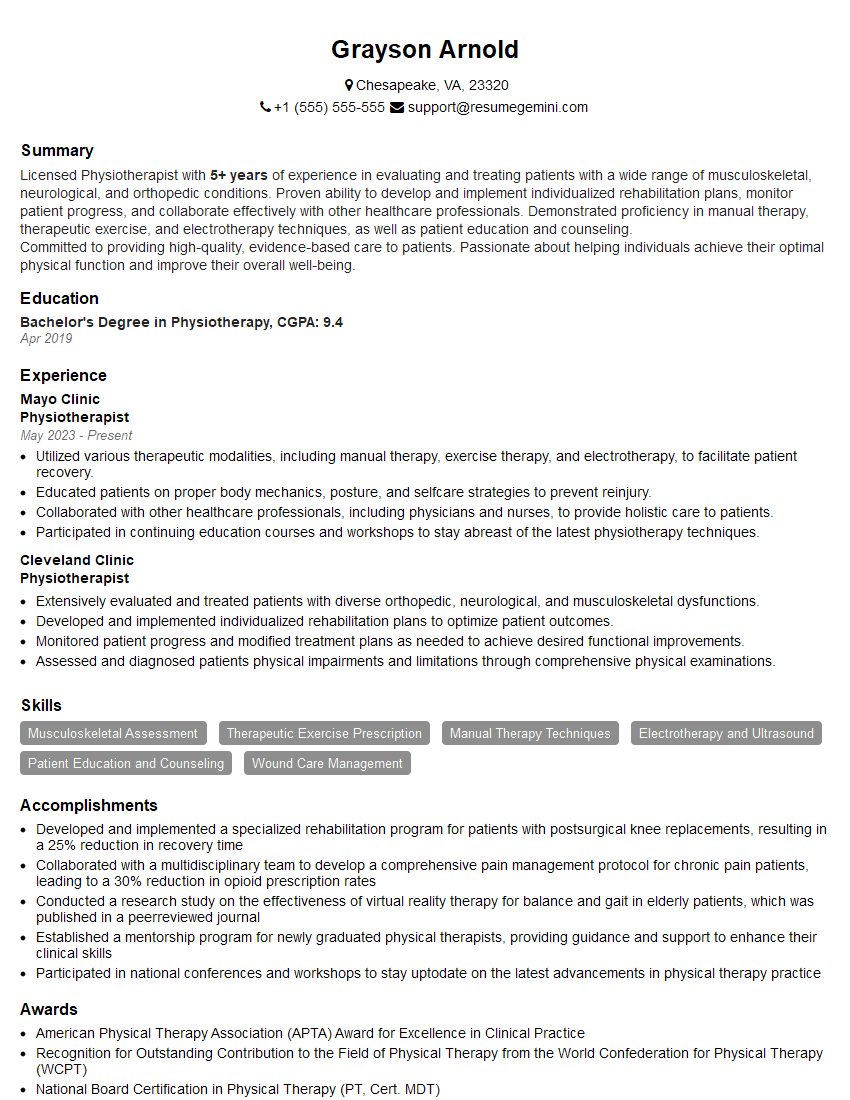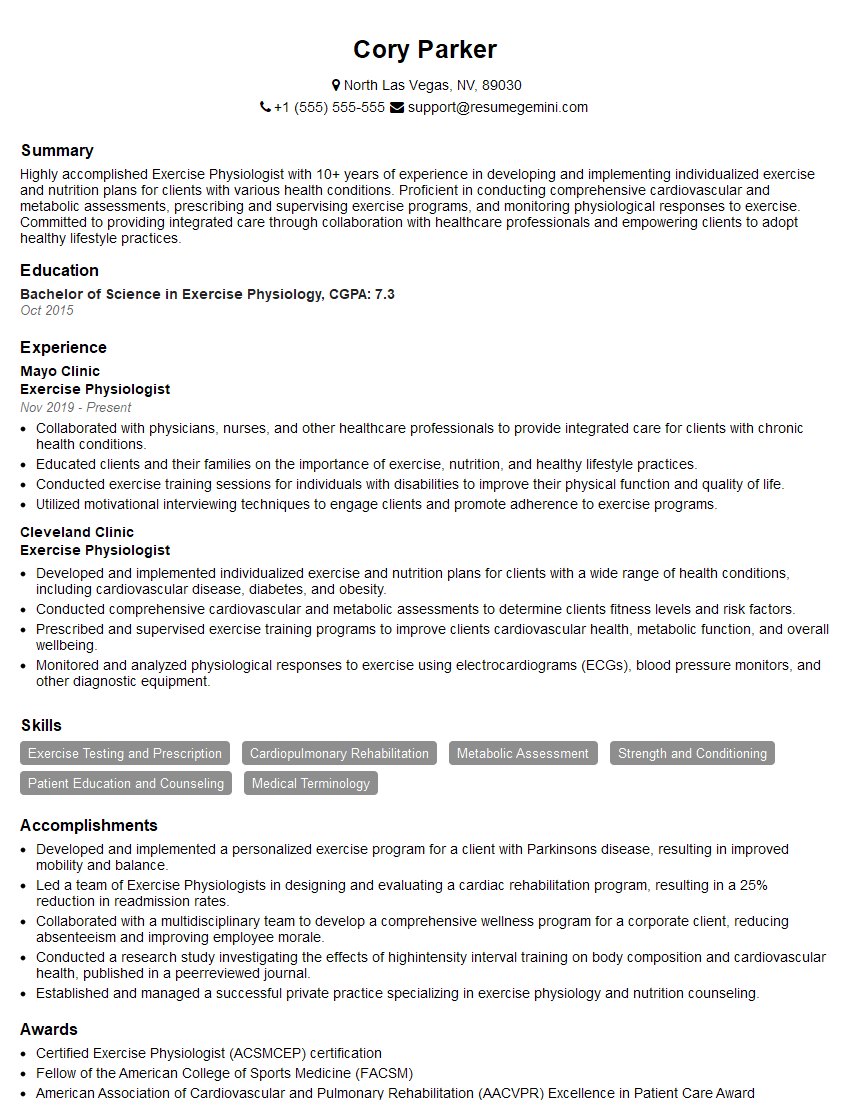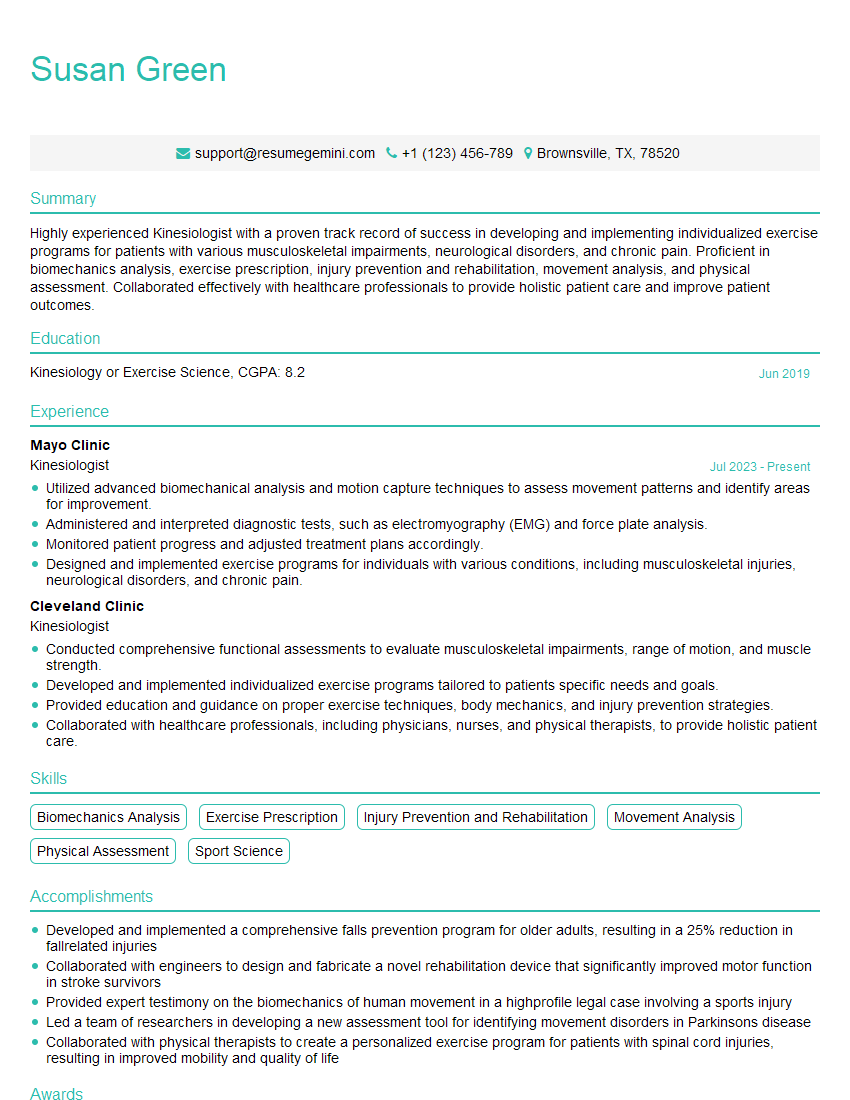Are you ready to stand out in your next interview? Understanding and preparing for Athlete Profiling interview questions is a game-changer. In this blog, we’ve compiled key questions and expert advice to help you showcase your skills with confidence and precision. Let’s get started on your journey to acing the interview.
Questions Asked in Athlete Profiling Interview
Q 1. Describe your experience with various athlete profiling methods.
My experience encompasses a wide range of athlete profiling methods, from the traditional to the cutting-edge. I’ve extensively used physiological testing, encompassing VO2 max assessments, lactate threshold determination, and body composition analysis. Beyond the physiological, I’ve incorporated psychological profiling tools such as personality inventories (like the Big Five personality traits) and motivational questionnaires. Furthermore, I’ve worked with movement analysis techniques, employing video analysis and motion capture to assess technique efficiency and identify areas for improvement. Finally, I’m proficient in utilizing performance data analysis from various sources such as GPS tracking systems, wearable sensors, and game statistics, to create a holistic athlete profile.
For example, with a young soccer player, I might use physiological tests to measure their aerobic capacity and anaerobic power. Simultaneously, I’d assess their psychological resilience using questionnaires and observe their decision-making and teamwork skills during training sessions. This multifaceted approach allows for a much more comprehensive understanding of their strengths and limitations.
Q 2. Explain the importance of physiological testing in athlete profiling.
Physiological testing is crucial in athlete profiling because it provides objective data about an athlete’s physical capabilities. This data forms the foundation of individualized training programs. By understanding an athlete’s aerobic capacity (VO2 max), anaerobic power, lactate threshold, strength, power, flexibility, and body composition, we can tailor training to maximize their potential and minimize the risk of injury. For instance, a high VO2 max indicates superior endurance, informing the design of aerobic training programs. Conversely, low anaerobic power might guide the design of strength and conditioning exercises targeted at improving this aspect.
Think of it as building a house. You wouldn’t start construction without a blueprint. Similarly, you can’t create effective training plans without understanding the athlete’s physiological foundation. The physiological profile is that blueprint.
Q 3. How do you integrate psychological assessments into athlete profiles?
Psychological assessments are integrated to understand the mental aspects that significantly impact athletic performance. These assessments don’t just gauge personality; they delve into factors like motivation, stress management, coping mechanisms, and self-belief. I employ a combination of questionnaires, interviews, and observational techniques. For instance, the Sport Competition Anxiety Test (SCAT) helps evaluate an athlete’s anxiety levels during competition. This information then informs the development of mental skills training programs to enhance focus, manage anxiety, and build resilience.
Integrating this with physiological data is critical. For example, an athlete with high physiological potential but low self-confidence might underperform. Addressing this psychological aspect, through tailored strategies, could unlock their full potential, highlighting the crucial interplay between the physical and the mental in athletic performance.
Q 4. What are the key metrics you consider when analyzing an athlete’s performance data?
The key metrics I consider vary depending on the sport and the athlete’s level, but generally include:
- Physiological Metrics: VO2 max, lactate threshold, anaerobic capacity, power output, strength, flexibility, body composition.
- Performance Metrics: Speed, agility, endurance, technique efficiency (e.g., running economy, shooting accuracy), and game statistics (e.g., goals scored, tackles made).
- Psychological Metrics: Anxiety levels, self-confidence, motivation, attention, and concentration.
For a marathon runner, VO2 max and lactate threshold would be paramount. For a basketball player, metrics like agility, shooting accuracy, and decision-making under pressure would be crucial.
Q 5. How do you identify strengths and weaknesses in an athlete’s profile?
Identifying strengths and weaknesses involves a comparative analysis of the collected data against established norms or benchmarks relevant to the sport. For example, comparing an athlete’s VO2 max to the average for their position in their sport. Weaknesses are areas where the athlete’s performance falls below the benchmark, while strengths are areas where they significantly exceed it. This analysis is often visualized using charts and graphs for easy interpretation.
It’s important to remember that a ‘weakness’ isn’t necessarily a failure. It’s an area for improvement. A strength, conversely, shouldn’t be taken for granted; it must be cultivated and honed further.
Q 6. Describe your experience using statistical software for athlete data analysis.
I’m highly proficient in using statistical software packages like R and SPSS for athlete data analysis. I utilize these tools for descriptive statistics (means, standard deviations), inferential statistics (t-tests, ANOVAs), and regression analysis to identify relationships between variables. For example, I might use regression analysis to determine the correlation between training volume and performance improvements. Data visualization is also a core component of my analysis, using tools within these packages and others to create meaningful graphs and charts that clearly present the findings.
#Example R code for calculating correlation: cor(athlete_data$training_volume, athlete_data$performance)
This code snippet demonstrates how I would use R to calculate the correlation between training volume and performance, which is a fundamental step in understanding the impact of training on performance. The specific statistical analyses depend on the research question and the type of data collected.
Q 7. Explain your understanding of talent identification and its role in athlete profiling.
Talent identification is the process of identifying individuals with the potential to excel in a specific sport. It plays a crucial role in athlete profiling because it allows for the early identification of promising athletes. This early identification allows for tailored training and development programs, increasing the likelihood of success. My approach incorporates both physiological and psychological assessments, combined with performance observation in talent identification processes.
For example, I might use specific tests measuring speed and agility in young track athletes, alongside assessments of their psychological traits like perseverance and competitiveness. This comprehensive approach helps me identify not only those with physical gifts, but also those with the mental fortitude to succeed.
Q 8. How do you tailor training programs based on individual athlete profiles?
Tailoring training programs based on individual athlete profiles is crucial for maximizing performance and minimizing injury risk. It’s not a ‘one-size-fits-all’ approach. We begin by comprehensively assessing the athlete’s physical capabilities, psychological traits, and training history. This assessment might include physiological tests (VO2 max, lactate threshold, strength testing), movement assessments (analyzing technique, identifying weaknesses), and psychological evaluations (assessing motivation, stress management, and mental resilience).
Once we have this data, we identify strengths and weaknesses. For example, a cyclist with a high VO2 max but weak lower body strength needs a program emphasizing strength training alongside endurance work. Conversely, an athlete with exceptional strength but poor endurance requires a training plan focusing on building aerobic capacity. The program is then designed to address these specific needs, gradually increasing intensity and volume based on the athlete’s response and progress. We regularly monitor the athlete’s progress, adjusting the plan as needed. This iterative process ensures the program remains effective and safe.
Q 9. How do you communicate athlete profiling results to coaches and athletes?
Communicating profiling results effectively is critical for buy-in and program success. I use a multi-faceted approach, starting with a clear, concise summary report highlighting key findings. This report uses plain language, avoiding jargon, and includes visual aids like graphs and charts to make the data easily digestible.
For coaches, the report focuses on practical applications: training recommendations, potential limitations, and areas for improvement. We discuss the findings collaboratively, allowing the coach to integrate the information into their existing training plans. With athletes, I focus on empowering them with knowledge. We discuss their strengths and areas for development in a supportive and encouraging environment, emphasizing realistic goals and the importance of consistent effort. This collaborative approach ensures everyone understands the process and is invested in the athlete’s success.
Q 10. Describe your experience in working with athletes from different sports.
My experience spans a wide range of sports, including endurance sports (cycling, running, triathlon), strength and power sports (weightlifting, powerlifting), and team sports (basketball, soccer). This diversity has provided valuable insights into the unique demands of each sport and the need for tailored profiling approaches. For instance, the profiling needs of a marathon runner will differ significantly from those of a powerlifter. Endurance athletes need extensive assessments of aerobic capacity, while power athletes require a focus on strength, power, and explosiveness. Adapting my profiling methodologies to these different demands is a key component of my expertise.
Working with athletes across various sports has also highlighted the importance of understanding the psychological aspects of performance. The mental demands on a golfer are different from those on a rugby player, and these factors must be considered when developing a comprehensive athlete profile.
Q 11. How do you handle conflicting information obtained from different assessment methods?
Conflicting information from different assessment methods is common. It’s rarely a case of one method being ‘right’ and another ‘wrong’; instead, it’s often a matter of understanding the limitations of each method and the context of the data. For example, a strength test might show an athlete is weak in a particular movement, while a movement analysis reveals poor technique contributing to that weakness. Both pieces of information are valuable.
My approach involves a systematic review of all data, considering the context and potential sources of error for each method. This involves looking for patterns and trends. I might triangulate the data – using multiple assessment methods to validate findings and identify discrepancies. If irreconcilable differences persist, I prioritize methods with higher validity and reliability. Open communication with the athlete and coaching staff is crucial in resolving any uncertainties.
Q 12. What is your experience with long-term athlete monitoring and its application in profiling?
Long-term athlete monitoring (LTAM) is invaluable for athlete profiling. It involves systematically tracking various performance and health metrics over extended periods, providing a rich dataset for understanding an athlete’s responses to training, recovery, and competition. This longitudinal perspective allows for the identification of subtle changes that might indicate emerging fatigue, overtraining, or injury risk. For example, tracking heart rate variability, sleep patterns, and training load over weeks or months helps us to optimize training schedules, avoiding overtraining or insufficient stimulus.
LTAM data informs adaptations to training programs in real-time. If an athlete shows signs of increased fatigue, we can adjust their training volume or intensity accordingly. This proactive approach helps prevent injuries and optimize performance. The data provides context for assessing the athlete’s responses to different training stimuli, leading to more effective and personalized program adjustments.
Q 13. Explain your approach to creating a comprehensive athlete development plan.
Creating a comprehensive athlete development plan involves a holistic approach. It’s more than just a training plan; it encompasses physical, psychological, and nutritional aspects. The first step is thorough athlete profiling as described earlier. This data forms the foundation for setting realistic and measurable goals. We collaboratively set short-term and long-term goals, ensuring alignment with the athlete’s aspirations and capabilities. The plan then outlines specific strategies to achieve those goals, detailing training programs, nutrition plans, recovery strategies, and psychological support.
The plan also incorporates regular reviews and adjustments. It’s a dynamic document, not a static one. We monitor the athlete’s progress closely, making adjustments based on their responses and feedback. The plan should be reviewed and updated at least every few months to ensure it remains relevant and effective in supporting the athlete’s development and progress. The communication aspect, keeping the athlete and coaching staff informed and involved throughout the process is crucial for success.
Q 14. How do you incorporate injury prevention strategies into athlete profiling?
Injury prevention is a central element of effective athlete profiling. It involves identifying risk factors for injury and implementing strategies to mitigate those risks. This requires a thorough assessment of the athlete’s movement patterns, muscle imbalances, and previous injury history. Movement screens, such as functional movement screens, identify weaknesses or asymmetries that could predispose the athlete to injury. For instance, identifying limited ankle dorsiflexion might increase the risk of lower leg injuries in a runner.
Based on these assessments, we incorporate injury prevention strategies into the athlete’s training plan. This might involve strengthening weak muscle groups, improving flexibility and mobility, and implementing appropriate warm-up and cool-down routines. Educating the athlete about proper techniques and posture is also crucial. We also monitor training load and recovery, using LTAM data to identify potential warning signs of overtraining or fatigue that can increase injury risk. A proactive, preventative approach is far more effective than reactive injury management.
Q 15. Describe your understanding of biomechanics and its role in athlete profiling.
Biomechanics is the study of movement and the forces acting upon the body. In athlete profiling, it plays a crucial role in understanding how an athlete moves, identifying strengths and weaknesses, and ultimately improving performance. We analyze factors such as joint angles, muscle activation patterns, and ground reaction forces to create a detailed picture of an athlete’s movement efficiency.
For example, analyzing a sprinter’s stride length and frequency can reveal areas for improvement in their running technique. By identifying inefficiencies, we can implement targeted training programs focusing on strength and conditioning to enhance their mechanics and, consequently, their speed.
Another application is in injury prevention. By analyzing movement patterns, we can identify individuals predisposed to certain injuries based on biomechanical deficiencies. Early identification allows for proactive intervention, through tailored exercises and modifications to training programs, to reduce injury risk. This is crucial for optimizing long-term athletic performance and career longevity.
Career Expert Tips:
- Ace those interviews! Prepare effectively by reviewing the Top 50 Most Common Interview Questions on ResumeGemini.
- Navigate your job search with confidence! Explore a wide range of Career Tips on ResumeGemini. Learn about common challenges and recommendations to overcome them.
- Craft the perfect resume! Master the Art of Resume Writing with ResumeGemini’s guide. Showcase your unique qualifications and achievements effectively.
- Don’t miss out on holiday savings! Build your dream resume with ResumeGemini’s ATS optimized templates.
Q 16. How do you stay updated on the latest advancements in athlete profiling techniques?
Staying current in athlete profiling requires a multifaceted approach. I regularly attend conferences and workshops, such as those hosted by the American College of Sports Medicine (ACSM) and the International Society of Biomechanics (ISB). These events provide insights into the newest research, technologies, and methodologies.
Furthermore, I maintain active subscriptions to leading sports science journals and regularly review literature databases such as PubMed and Google Scholar. I actively seek out publications on innovative technologies and techniques, particularly those related to wearable sensor technology and advanced data analytics. This allows me to understand the emerging trends and best practices in the field.
Finally, networking plays a crucial role. I engage with other professionals in the field through professional organizations and online communities, engaging in discussions and sharing knowledge to stay informed about the most recent developments.
Q 17. Describe a time you had to adapt your athlete profiling approach due to unforeseen circumstances.
During a recent project profiling a young female gymnast, we encountered an unforeseen challenge. We initially planned to use a motion capture system for detailed kinematic analysis. However, due to a sudden equipment malfunction just before testing, we had to quickly adapt our approach.
We immediately switched to a more manual observation-based assessment, incorporating detailed video analysis and using a standardized checklist for evaluating key aspects of her technique. While less precise than the planned motion capture analysis, this approach still allowed us to gather valuable data on her form, identify her strengths and weaknesses, and recommend specific areas for improvement. This experience highlighted the importance of flexibility and adaptability, as well as the value of having backup methods prepared in the event of unexpected disruptions.
This experience underscored the importance of having alternative methodologies in place and the ability to quickly assess and adapt our approach based on practical constraints. It taught me that effective athlete profiling isn’t just about sophisticated technology, but also about critical thinking and problem-solving.
Q 18. How do you ensure the ethical considerations in athlete profiling are met?
Ethical considerations are paramount in athlete profiling. We must prioritize the athlete’s well-being and autonomy. This begins with informed consent; every athlete must understand the purpose of the testing, the procedures involved, the potential risks and benefits, and how the data will be used and protected. Transparency and confidentiality are crucial.
Data privacy is ensured through secure data storage and adherence to relevant regulations such as HIPAA (in the US) or GDPR (in Europe). Data should only be accessed and used by authorized personnel, and all analysis and reporting should protect the athlete’s identity and sensitive information. Furthermore, we must be mindful of potential biases in our data collection and interpretation, ensuring fair and objective evaluations.
Finally, we must be sensitive to the emotional impact of our findings. We strive to provide constructive feedback in a way that supports and empowers the athlete. Our role is not just to identify weaknesses but to help the athlete develop strategies for improvement and reach their full potential.
Q 19. Explain your familiarity with different types of performance testing equipment.
My experience encompasses a wide range of performance testing equipment. This includes:
- Force plates: Used to measure ground reaction forces, providing valuable insights into an athlete’s power output, jump height, and movement efficiency.
- Motion capture systems: These systems, employing cameras and markers, allow for detailed three-dimensional analysis of movement patterns, joint angles, and velocities.
- Wearable sensors: Such as accelerometers, gyroscopes, and GPS trackers, these provide real-time data on movement, speed, and other performance metrics, both in the lab and in field settings.
- Metabolic carts: Used to assess VO2 max, respiratory exchange ratio, and other physiological parameters during exercise.
- Electromyography (EMG) systems: These measure muscle activation patterns, providing insights into neuromuscular function and coordination.
Choosing the right equipment depends on the specific needs of the athlete and the goals of the assessment. For example, while motion capture provides highly detailed data, it can be expensive and may not be suitable for all environments. Wearable sensors, on the other hand, offer a more portable and cost-effective alternative for certain applications.
Q 20. How do you interpret and use VO2 max data in athlete profiling?
VO2 max, or maximal oxygen consumption, is a crucial metric in athlete profiling, representing the body’s maximal capacity to transport and utilize oxygen during exercise. It’s a strong indicator of cardiorespiratory fitness and endurance capacity.
We interpret VO2 max data within the context of the athlete’s sport and training level. A high VO2 max indicates excellent aerobic capacity, which is particularly important in endurance sports. However, the significance of a specific VO2 max value varies depending on the athlete’s sport and position. A soccer player might need a different VO2 max than a marathon runner. We compare the athlete’s VO2 max to normative data for their age, sex, and sport, to assess their relative fitness level.
This data informs training programs. Athletes with lower VO2 max values may need increased aerobic training, while those with high values might focus on other aspects of performance, such as strength and power. Changes in VO2 max over time can also track the effectiveness of training interventions.
Q 21. What is your experience with analyzing movement patterns to improve athletic performance?
Analyzing movement patterns is a core aspect of my work. We use a combination of video analysis, motion capture, and sometimes even direct observation to identify any inefficiencies in an athlete’s technique. These inefficiencies can lead to reduced performance, increased injury risk, or both.
For example, in a baseball pitcher, we might analyze their throwing mechanics to identify any deviations from optimal form. Analyzing joint angles, velocities, and sequencing of movements can help us pinpoint specific areas for improvement, such as improving arm slot or reducing stress on the elbow joint. This analysis informs targeted training programs focused on improving strength, flexibility, and motor control to refine technique.
We can also identify asymmetries in movement patterns, which can contribute to injury risk. For instance, if a runner shows a significant difference in stride length between legs, we would work to address any underlying muscle imbalances or biomechanical limitations that could lead to knee pain or other running-related injuries. Our goal is to improve movement efficiency, optimize performance, and reduce injury risk by enhancing an athlete’s technique through targeted intervention.
Q 22. Describe your proficiency in using various athlete tracking technologies.
My proficiency in athlete tracking technologies spans a wide range of tools, from basic wearable sensors to sophisticated GPS tracking systems and advanced biomechanical analysis software. I’m experienced with using GPS devices like Catapult and Zephyr to monitor training load, speed, and distance. I’m also adept at interpreting data from wearable sensors like accelerometers and gyroscopes, which provide insights into movement patterns, muscle activation, and fatigue. Furthermore, I’m proficient in using force plates and motion capture systems for detailed biomechanical analysis, allowing us to identify areas for technical improvement and reduce injury risk. For example, I recently used Catapult data to identify a period of overtraining in a group of sprinters, leading to a successful adjustment in their training regimen.
Beyond hardware, I’m skilled in using various software platforms for data analysis, visualization, and reporting. This includes specialized sports analytics software, as well as standard statistical packages like R and Python for deeper data dives. My expertise allows me to integrate data from multiple sources to create a comprehensive understanding of an athlete’s performance.
Q 23. How do you quantify the effectiveness of interventions based on athlete profile data?
Quantifying the effectiveness of interventions relies heavily on comparing pre- and post-intervention data, using the athlete’s profile as a baseline. For instance, if we implement a new strength training program, we’d track changes in key performance indicators (KPIs) like maximal strength, power output, and speed. We use statistical analysis to determine if the observed changes are statistically significant and meaningfully improved the athlete’s performance.
This often involves the use of control groups or pre-existing data to establish a baseline. We might use effect sizes (like Cohen’s d) to quantify the magnitude of the improvement. For example, a Cohen’s d of 0.8 indicates a large effect, signifying a substantial improvement due to the intervention. We also consider the athlete’s subjective feedback and any qualitative changes observed through performance analysis. A holistic approach combining quantitative and qualitative data allows for a thorough evaluation of the intervention’s success.
Q 24. Explain your understanding of the impact of nutrition on athlete performance.
Nutrition plays a pivotal role in athletic performance, influencing everything from energy availability and muscle protein synthesis to recovery and immune function. A well-planned nutrition strategy ensures adequate energy intake to fuel training, optimize muscle growth and repair, and maintain hydration. The timing of nutrient intake is crucial; for example, consuming carbohydrates and protein post-workout aids in muscle recovery and glycogen replenishment.
Nutritional deficiencies can lead to decreased performance, impaired immune function, and increased susceptibility to injury. Conversely, a well-designed nutrition plan can enhance endurance, strength, and speed. I work closely with registered dietitians to develop personalized nutrition plans tailored to each athlete’s specific needs, training demands, and dietary preferences. For instance, I helped a long-distance runner address iron deficiency through dietary modifications and supplementation, resulting in a significant improvement in her endurance performance.
Q 25. How do you ensure the confidentiality and privacy of athlete data?
Confidentiality and privacy are paramount in athlete profiling. We adhere to strict data protection protocols, including secure data storage, access control measures, and anonymization techniques. All data is stored on encrypted servers with limited access granted only to authorized personnel. We comply with relevant data protection regulations, such as GDPR and HIPAA, ensuring the athlete’s data is handled responsibly and ethically.
Informed consent is obtained from each athlete before collecting and using their data. We provide transparent information about how their data will be used and stored, and we maintain detailed records of all data processing activities. We also have strict protocols for data breach management and regularly review our security measures to ensure they remain effective and up-to-date.
Q 26. Describe your experience in collaborating with multidisciplinary teams in athlete profiling.
I have extensive experience collaborating with multidisciplinary teams. Athlete profiling is inherently collaborative, requiring input from coaches, medical professionals, nutritionists, and strength and conditioning specialists. I’ve worked in settings where effective communication and data sharing are essential. My role often involves integrating data from various sources to create a comprehensive athlete profile. For example, I recently collaborated with a team to profile a young tennis player, where I integrated biomechanical data, performance metrics from matches, and feedback from the coach and physiotherapist to provide a holistic picture of the athlete’s strengths and weaknesses, and guide the development of personalized training plan.
Effective collaboration depends on clear communication, shared goals, and a mutual understanding of each professional’s expertise. My approach emphasizes active listening, open communication, and the constructive use of feedback to ensure a collaborative and productive work environment.
Q 27. How do you use athlete profiles to inform recruitment decisions?
Athlete profiles play a significant role in recruitment decisions. By analyzing an athlete’s physical capabilities, technical skills, and psychological attributes, we can assess their potential to succeed at a given level of competition. This data-driven approach reduces reliance on subjective judgments, ensuring that recruitment decisions are based on objective evidence.
For instance, I used athlete profiling data to identify a young basketball player who possessed exceptional speed, agility, and court vision, but also highlighted areas needing improvement. This information not only helped to make a data driven recruitment decision, but also provided a roadmap for development within the organisation. We use statistical modeling and predictive analytics to identify athletes with the highest probability of success, matching their profiles with the team’s specific needs and strategic goals.
Q 28. Describe your experience with developing and presenting athlete reports.
Developing and presenting athlete reports is a crucial aspect of my role. These reports synthesize the collected data, providing a concise and actionable overview of the athlete’s strengths, weaknesses, and areas for development. I use clear and concise language, avoiding jargon wherever possible, to ensure that the information is easily understood by coaches and other stakeholders.
Reports often include visual aids such as charts and graphs to enhance understanding and emphasize key findings. The presentation format is tailored to the audience, whether it’s a detailed report for the coaching staff or a summary report for the athlete. For example, I recently created a report for a professional cyclist, detailing their power output, cadence, and heart rate data from recent races, along with recommendations for training adjustments to improve their performance in upcoming competitions. The report’s visual presentation made it very easy for both the coach and the cyclist to understand and act upon the recommendations.
Key Topics to Learn for Athlete Profiling Interview
- Physiological Assessment: Understanding and interpreting physiological data (e.g., VO2 max, lactate threshold) to assess athletic performance capabilities.
- Biomechanical Analysis: Applying biomechanical principles to analyze movement patterns and identify areas for improvement in technique and performance.
- Psychological Profiling: Evaluating an athlete’s mental fortitude, resilience, and coping mechanisms to optimize performance and well-being.
- Nutritional Strategies: Designing personalized nutrition plans tailored to an athlete’s specific needs, training regimen, and performance goals.
- Performance Monitoring & Data Analysis: Utilizing technology and data analysis techniques to track progress, identify weaknesses, and adjust training programs accordingly.
- Injury Prevention & Rehabilitation: Identifying risk factors for injury and developing strategies for prevention and effective rehabilitation.
- Talent Identification & Development: Assessing athletic potential in young athletes and designing development plans to maximize their capabilities.
- Ethical Considerations: Understanding the ethical implications of athlete profiling and ensuring fair and responsible practices.
- Practical Application: Discuss how you would use profiling data to create a tailored training plan for a specific athlete, addressing their individual strengths and weaknesses.
- Problem-Solving: Prepare to discuss how you would approach challenges such as inconsistent data, conflicting information from different assessments, or athlete resistance to suggested changes.
Next Steps
Mastering Athlete Profiling opens doors to exciting career opportunities in sports science, coaching, and performance enhancement. To maximize your job prospects, crafting a compelling and ATS-friendly resume is crucial. ResumeGemini is a trusted resource to help you build a professional resume that showcases your skills and experience effectively. Examples of resumes tailored to Athlete Profiling are available to help guide you through the process. Invest the time in creating a strong resume – it’s your first impression and a key step to landing your dream role.
Explore more articles
Users Rating of Our Blogs
Share Your Experience
We value your feedback! Please rate our content and share your thoughts (optional).
What Readers Say About Our Blog
Hi, I represent an SEO company that specialises in getting you AI citations and higher rankings on Google. I’d like to offer you a 100% free SEO audit for your website. Would you be interested?
Hi, I represent an SEO company that specialises in getting you AI citations and higher rankings on Google. I’d like to offer you a 100% free SEO audit for your website. Would you be interested?
Dear Sir/Madam,
Do you want to become a vendor/supplier/service provider of Delta Air Lines, Inc.? We are looking for a reliable, innovative and fair partner for 2025/2026 series tender projects, tasks and contracts. Kindly indicate your interest by requesting a pre-qualification questionnaire. With this information, we will analyze whether you meet the minimum requirements to collaborate with us.
Best regards,
Carey Richardson
V.P. – Corporate Audit and Enterprise Risk Management
Delta Air Lines Inc
Group Procurement & Contracts Center
1030 Delta Boulevard,
Atlanta, GA 30354-1989
United States
+1(470) 982-2456
